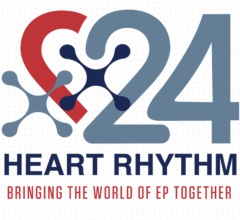
May 24, 2023 — Rhythm Technologies, Inc., a leading digital health care company focused on creating trusted solutions that detect, predict, and prevent disease, announced the presentation of four studies at the Heart Rhythm Society’s annual meeting, Heart Rhythm 2023, in New Orleans, LA. These new data reinforce the body of clinical evidence that long-term ambulatory cardiac monitoring of up to 14 days with Zio XT increases diagnostic yield and improves diagnostic accuracy of ventricular arrhythmias across a wide range of patient populations.
These new scientific data from iRhythm build on the totality of clinical evidence – including real-world comparative effectiveness and head-to-head studies – that continue to highlight the value of iRhythm’s Zio products and services.
Life-threatening ventricular arrhythmias, specifically ventricular tachycardia and ventricular fibrillation, cause about 300,000 deaths per year in the US and account for almost half of deaths from cardiac causes. Early detection and diagnosis are crucial to treating these arrhythmias and preventing adverse health outcomes.
“These studies thematically showcase the value of iRhythm’s Zio products and services — in particular for identifying ventricular arrhythmias for risk stratification and disease management,” said Mintu Turakhia, MD, MAS, iRhythm’s chief medical officer, chief scientific officer and executive vice president, product innovation. “The findings have important clinical and scientific implications, and they further demonstrate the strength of our technology across the complete range of clinical arrhythmias.”
Extended Ambulatory ECG Monitoring Enhances Identification of Higher-risk Patients With Hypertrophic Cardiomyopathy
The EXAMINE-HCM study found that in patients with hypertrophic cardiomyopathy (HCM) – a disease of the heart affecting 1 in 500 people in the U.S. that can lead to an increased risk of sudden cardiac death – long-term monitoring of up to 14 days with the Zio XT service substantially improves diagnostic yield of non-sustained ventricular tachycardia (NSVT). This may be highly consequential for assessing risk of arrhythmias and defining treatment pathways in these patients.
Key findings:
- Diagnostic yield for detecting NSVT was substantially increased using 14 days of monitoring, with 48 hours of monitoring missing nearly two-thirds of patients with high-risk NSVT episodes that may impact risk stratification and treatment.
- Diagnostic yield of detecting NSVT was 18% during the first 48 hours of monitoring compared to 48% at 14 days, with 63% of the initial NSVT episodes occurring after the first 48 hours.
- Diagnostic yield of detecting high-risk NSVT episodes was 8% during the first 48 hours as compared to 24% at 14 days, with 64% of the initial high-risk NSVT runs occurring after the first 48 hours.
The PVC Burden Analysis study: Premature Ventricular Complexes (PVC): Assessing Burden Density in a Large National Cohort Population to Better Define Optimal ECG Monitoring Duration
The PVC Burden Analysis study of 106,705 patients shows increased monitoring through at least seven to 10 days duration is associated with improved accuracy in categorization of patients by PVC burden level. The findings are important, as misclassification could impact clinical decision-making.
Key findings:
- A 48-hour estimation of PVCs misclassified PVC burden compared to 14 days of ambulatory ECG monitoring.
- At least seven days of continuous ambulatory ECG monitoring, performed by the Zio service, was necessary to achieve >95% accuracy in burden categorization.
The Non-sustained VT Prognostic study: Practice Variation After Ambulatory ECG Detection of Non-sustained Ventricular Tachycardia in the Non-Cardiac Patient
In the Non-sustained VT Prognostic study, a retrospective study from the Veterans Health Administration, the largest integrated health care system in the United States, nearly one-third of the 58,279 patients who received long-term ambulatory ECG monitoring of up to 14 days with Zio had NSVT. Findings highlight the opportunity to create risk models and integrated care pathways following ambulatory ECG monitoring.
Key finding:
- There was a wide site-level variation in diagnostic testing and treatment in the VA Health Care System after detection of NSVT, such as in the proportion of patients with echocardiograms, coronary angiograms, stress testing, cardiology care, and use of cardiovascular medications in the 90 days following ambulatory monitoring.
The Flec-ARVC study: Randomized Placebo-controlled Trial of Flecainide in Patients With Arrhythmogenic Right Ventricular Cardiomyopathy
The Flec-ARVC study, conducted at the University of Rochester, the Johns Hopkins ARVC Program and other institutions outside of iRhythm, is the first randomized clinical trial evaluating flecainide in arrhythmogenic right ventricular cardiomyopathy (ARVC). ARVC is an inherited heart disorder that carries a high risk of ventricular tachycardia and sudden death, often in young persons. Although implantable cardioverter defibrillators (ICD) can prevent sudden cardiac death, recurrent ventricular arrhythmias can be a significant clinical challenge, and there is limited trial data on the efficacy of antiarrhythmic therapy for ventricular arrhythmia suppression. The use of Zio services highlights Zio’s PVC burden measurement capabilities and more broadly, the opportunity to use the Zio service in clinical trials and research.
Key finding:
- In this randomized, placebo-controlled, crossover trial of 41 patients that received Zio XT ambulatory ECG monitoring for seven days, Flecainide significantly reduced PVC burden.
About the “Extended Ambulatory ECG Monitoring Enhances Identification of Higher-risk Patients With Hypertrophic Cardiomyopathy” study
Authors: Ethan J. Rowin, MD; Gaurav Das, MD; Christopher Madias, MD; Mike Hsu, PhD; Lori Crosson, PhD; Barry J. Maron, MD; Mintu P. Turakhia, MD, MAS; Martin S. Maron, MD
The study authors evaluated 236 hypertrophic cardiomyopathy (HCM) patients (49 ± 12 years; 72% male) without primary prevention implantable cardioverter defibrillators judged previously to be at low or intermediate sudden death (SD) risk with 14-day continuous ambulatory monitoring through Zio XT. Episodes of NSVT were evaluated during the initial 48 hours of monitoring and compared to NSVT identified in subsequent two to 14 days. NSVT episodes with ≥1 of the following criteria were considered higher risk as a SD marker: ≥ 200 bpm, ≥ eight beats, ≥ three runs within a consecutive 48 hour period. Among the 236 patients, 114 (48%) had ≥ one runs of NSVT, with a median of two runs (IQR: 1-4) during the complete monitoring period, including 86 patients with ≤ four runs (36%), 13 with five through nine runs (6%), and 15 with ≥10 runs (7%). Diagnostic yield of detecting NSVT was 18% during the first 48 hours of monitoring compared to 48% at 14 days, with 63% of the initial NSVT episodes occurring after the first 48 hours (72 of 114). Similarly, diagnostic yield of detecting high risk NSVT episodes was 8% during the first 48 hours as compared to 24% at 14 days, with 64% of the initial high-risk NSVT runs occurring after the first 48 hours (36 of 56).
About the “Premature Ventricular Complexes: Assessing Burden Density in a Large National Cohort Population to Better Define Optimal ECG Monitoring Duration” study
Authors: Andrew Krumerman, MD; Luigi Di Biase, MD, PhD; Jay J. Chudow, MD; Ardit Kacorri, MD; Lori Crosson, PhD; Alan Wilk, BS; Kevin J. Ferrick, MD
Patients with a PVC burden ≥5%, age ≥18 and a ≥13-day wear period were analyzed between June 2011 to April 2022. Patient demographics were reported, and the mean absolute error in PVC burden was calculated at baseline (<10 sec), 24 hours, 48 hours, and daily to14 days. Burden at the end of the wear period was considered the true value for PVC burden. The measured error was described for each subinterval (mean, SD, median, IQR). The accuracy in PVC burden was evaluated across monitoring durations at 10% (low),15% (moderate) and 20% (high) thresholds. There were 106,705 patients analyzed. PVC density was more frequent in males than females, 66:34 respectively and in those older than 65 years of age. The PVC burden mean absolute error was calculated at baseline (<10sec), 24 hours, 48 hours, seven days, and 13 days (Figure1). When comparing PVC burden densities with lower and higher than 20% at 24 hours and 7 days, data showed a decrease in mean absolute error from 2.78% and 3.97% at 24 hours to 1.27% and 1.75% at seven days. Furthermore, the accuracy in categorization of PVC burden at a 15% threshold increased from 89.2% at 24 hours to 95.1% at seven days.
About the “Practice Variation After Ambulatory ECG Detection of Non-sustained Ventricular Tachycardia in the Non-Cardiac Patient” study
Authors: Krishna Pundi, MD; Jun Fan, MS; Natasha Din, MBBS, MAS; Alex T. Sandhu, MD, MS; Paul A. Heidenreich, MD, MS; Mintu Turakhia MD, MAS
The authors performed a retrospective cohort study using data from the Veterans Health Administration, the largest integrated health system in the U.S. They included patients who received a Zio XT monitor between 11/18/2011 and 6/23/2020 and excluded those with history of arrhythmias, atherosclerotic disease, or heart failure. The authors defined NSVT as at least one VT episode ≥3 beats but <30 seconds in duration. They determined healthcare utilization and medication prescription within 90 days of the Zio monitor and examined site-level variation in care. The authors analyzed 58,279 patients without known cardiac disease, of whom 18,792 (32.2%) had NSVT. They matched 18,263 NSVT patients (97.2%) to 89 unique sites for the site-level analysis. There was substantial site-level variation in the proportion of patients with echocardiograms, coronary angiograms, stress testing, cardiology care, and prescriptions filled within 90 days of monitoring. After adjusting for baseline characteristics and medications, the authors only found significant associations between Charlson Comorbidity Index and echocardiogram use (odds ratio [OR]: 0.95, 95% confidence interval [CI]:0.91-0.99, p=0.008), age and stress testing (OR 0.92, 95% CI: 0.88-0.95, p<0.0001), and high-volume sites and cardiology care (OR 1.83, 95% CI: 1.16-2.89, p=0.01).
About the “Randomized Placebo-controlled Trial of Flecainide in Patients With Arrhythmogenic Right Ventricular Cardiomyopathy” study
Authors: Wojciech Zareba, MD, PhD; Crystal Tichnell, MS; Spencer Z. Rosero, MD; Marina Cerrone, MD; Matthew M. Zipse, MD; Francis E. Marchlinski, MD; Albert Y. Sun, PhD; Julia H. Indik, MD, PhD; Cynthia A. James, PhD; Luisa Mestroni, MD; Kristina Cutter; Derick R. Peterson, PhD; Scott McNitt, MS; Bronislava Polonsky, MS; James P. Daubert, MD; Mark C. Haigney, MD; Matthew Needleman, MBA; David Oakes, PhD; Mario Delmar, MD, PhD; Hugh Calkins, MD
The study authors conducted an NIH-funded pilot clinical trial hypothesizing flecainide administration is more effective than placebo in reducing the burden of ventricular premature beats (VPBs) in ARVC patients. The study was designed as a randomized double-blinded placebo-controlled crossover trial in ARVC patients with administration of 100 mg bid of flecainide or matching placebo for four weeks each with a washout period. The primary specific aim was to determine whether flecainide administration is associated with a significant reduction of VPBs in comparison to placebo, measured on 7-day Zio patch monitoring. The mean and median number of VPBs/day was significantly lower on flecainide than placebo. At least 50% reduction in VPBs/day was observed in 79% and at least 75% reduction in 53% of patients. The primary analysis showed that flecainide reduced the VPB rate by 72% (p < 0.0001, 95% CI: 56-82%), adjusted for the period effect. The study concluded that flecainide significantly reduced the VPB rate and NSVT/VT/VF rate supporting clinical use of this medication in ARVC patients.
To learn more about iRhythm, including its portfolio of Zio products and services, please visit irhythmtech.com.


 July 30, 2024
July 30, 2024 








